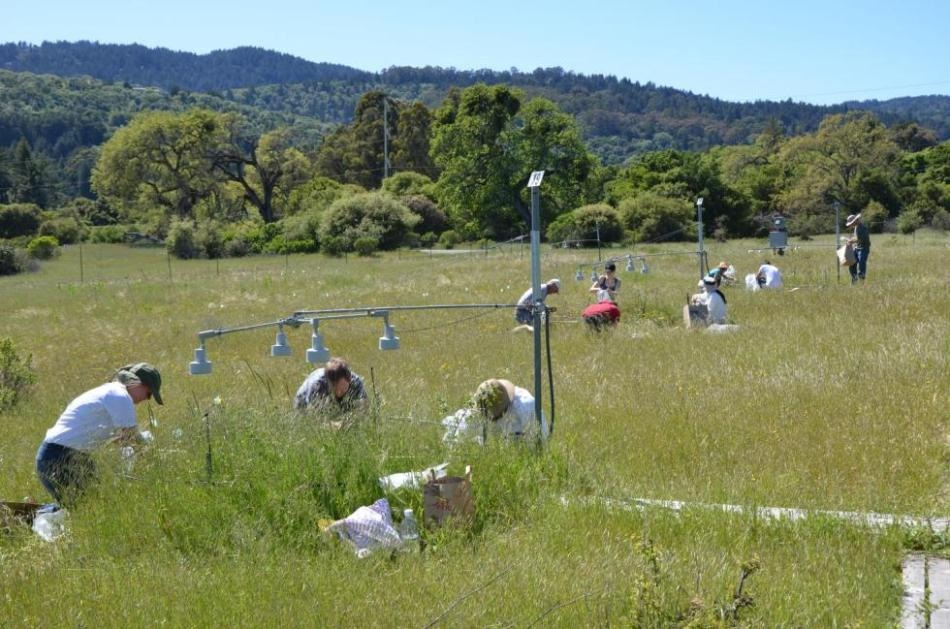Sep 6 2016
One of the world’s longest-running, most comprehensive climate change experiments produced some surprising results. The extensive experiment subjected grassland ecosystems to sixteen possible future climates and measured many aspects of ecosystem performance and sustainability. This study, appearing in the September 5, 2016, Early Online Edition of the Proceedings of the National Academy of Sciences, reports on 17 years of plant growth, an important bellwether of ecosystem health. Plant growth varied tremendously from year to year, reaching a peak under conditions near the average over the last several decades. As conditions move away from the averages, as happens with climate change, plant growth fell.
 Participants in the Jasper Ridge Global Change Experiment sampled plots of the grassland ecosystem for 17 years. (CREDIT: Nona Chiariello)
Participants in the Jasper Ridge Global Change Experiment sampled plots of the grassland ecosystem for 17 years. (CREDIT: Nona Chiariello)
The findings are from the Jasper Ridge Global Change Experiment, which is directed by Chris Field, the founding director of Carnegie’s Department of Global Ecology. Unlike most climate-change experiments that altered one or maybe two aspects of the environment, the Jasper Ridge Global Change Experiment altered four aspects of climate change—temperature, precipitation, atmospheric composition (carbon dioxide concentration), and atmospheric deposition (nitrogen pollution). With all possible combinations of ambient and elevated levels of the four factors, the study explored ecosystem responses to sixteen different possible futures.
The study ecosystem, a typical California grassland, is ideal for this kind of experiment because it has many species, even small plots express a wide range of ecosystem processes, and the short lifetime of most species means that an experiment can encompass many generations of the most important organisms.
“Plant growth varied by more than three times over the years and the range of treatments,” remarked lead author Kai Zhu who was at Carnegie and Stanford when the work was conducted and is now at Rice University. “Good conditions tend to look like the recent past, and bad conditions look more common in a world of climate change. But we did not see progressive effects, meaning that we did not see that one bad year makes the next year bad as well. We think year-to-year variability acts as a reset button.”
Field said, “For understanding impacts of climate change and options for dealing with it, one important result was the absence of a strong response to elevated atmospheric carbon dioxide. Data from some ecosystems indicate that elevated atmospheric carbon dioxide might compensate for negative effects of warming or drought, sustaining ecosystem health and potentially removing carbon dioxide from the atmosphere. The absence of such compensation in this long-term, comprehensive experiment emphasizes that solving the carbon dioxide problem will require cutting emissions and planting forests. We can’t count on a free helping hand from nature.”
Analysis of the impacts of individual factors showed that warming had negative effects on plant growth. Plant growth peaked when precipitation was close to historic averages. There was no consistent response to elevated atmospheric carbon dioxide. Nitrogen pollution led to a 23% increase in plant growth, a typical response in nitrogen-limited ecosystems.
Scenarios with combined factors mostly resulted in this same pattern, but with a few surprises. Specifically, the response to combined warming and increased precipitation was larger than the sum of the individual responses when they happened in isolation. But the response of plant growth to warming and nitrogen pollution was smaller than the sum of each individual effect occurring alone. The maximum plant growth occurred when both temperature and precipitation were at levels typical of average conditions over the last several decades. Plant growth declined with rising temperature and with precipitation either lower or higher than long-term averages.
Field commented, “In Jasper Ridge grasslands, we see an ecosystem finely adapted to historic conditions. Providing a chance for places like this will require ambitiously tackling climate change so that we stabilize warming at the low end of the possible range. That is our challenge for the future.”